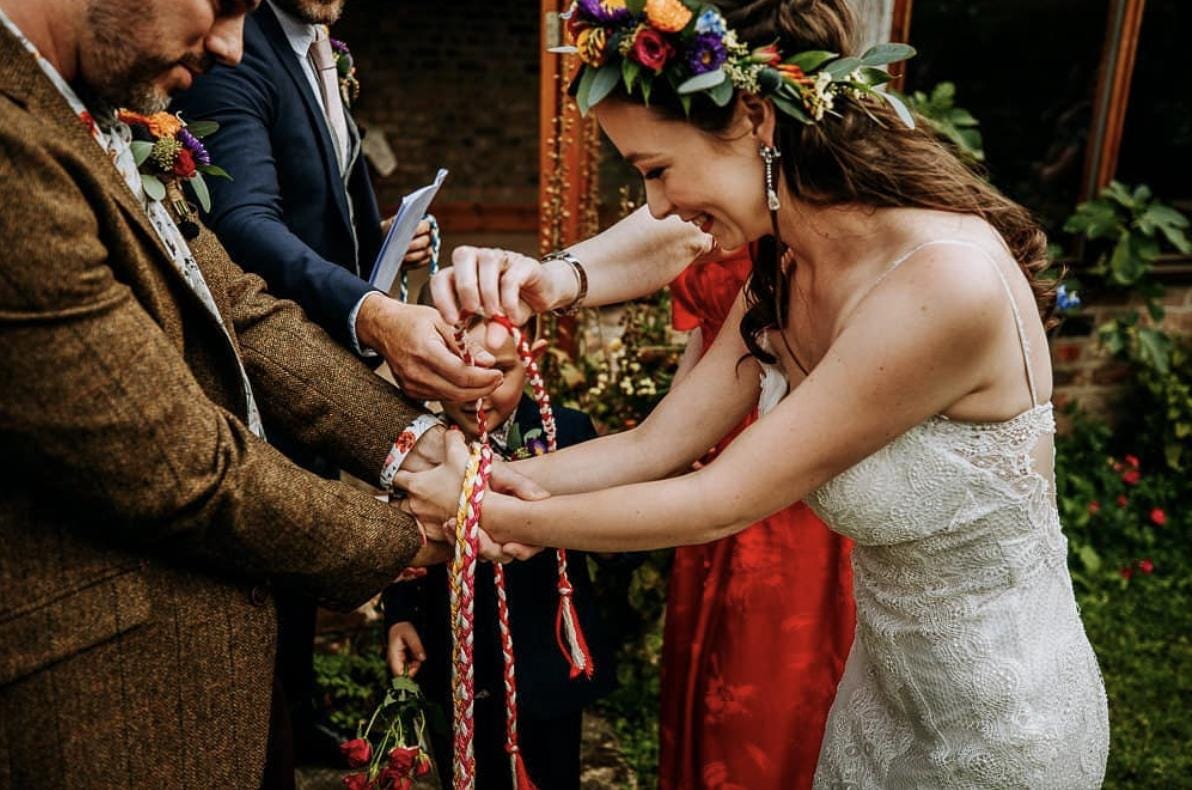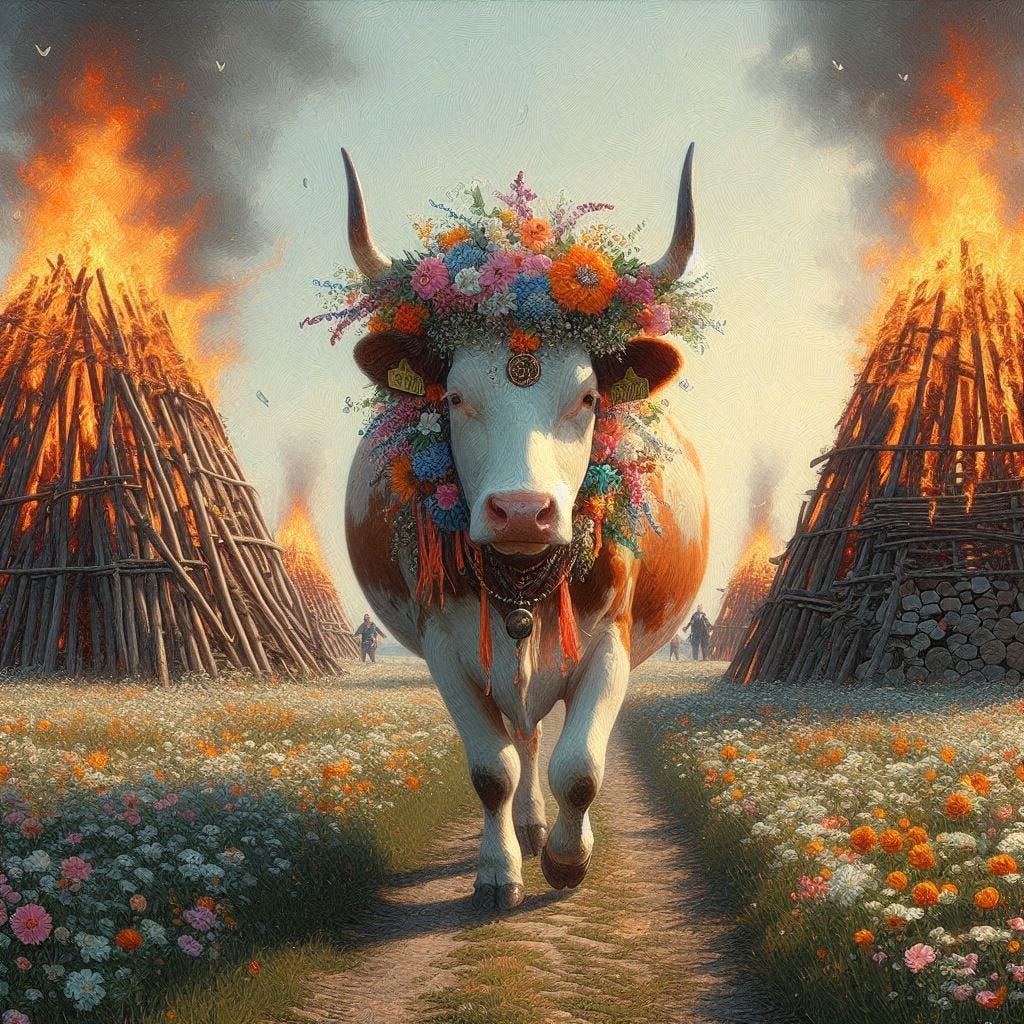In the northern hemisphere, Halloween approaches on October 31st but here in the southern hemisphere, October 31 marks Beltane Eve, a night when traditionally Beltane bonfires would be lit and Beltane celebrations begin. However, now is not a good time to be lighting bonfires, especially in Australia. The fire season has started and the threat of wildfire grows. Rules for outdoor fires are strict and require approval from local fire brigades or councils with heavy fines for those that start fires illegally. Instead of risking fines or wildfires, you could light candles in place of bonfires. A burning candle might not be as spectacular but can be just as meaningful and quite beautiful.
Last week, we explored arguments for celebrating Beltane rather than Halloween at this time of year and we dove into the witchy celebration of Walpurgisnacht (‘Walpurgis Night’), also called Hexanacht (‘Witches Night’). In this episode, the second of four focused on Beltane, we explore the sacred balefires lit across much of Europe during this season on April 30 or May Eve in the northern hemisphere.


Lighting the Balefires
Beltane is one of two main Celtic fire celebrations, the other being Samhain (Halloween) in Autumn. Ancient Celts are thought to have marked only two seasons in their calendars. The season of winter started on Samhain or Halloween, and the season of summer began on Beltane or May Day. Across the British Isles and much of the entire European continent, bonfires were lit on Beltane (May) Eve, often on the top of hills close to settlements. These fires were usually lit in a ritual involving forced-fire, also called a need-fire, using friction from rubbing two sticks or pieces of wood together.
Need-fires were thought to be healing or purifying and were commonly used in folk magic/medicine to ward off evil (in the form of faeries or witchcraft) or disease. Communal and ceremonial need-fires were constructed of large logs, which required a number of people to manoeuvre. Many of these communal need-fires in Gaelic-speaking lands were traditionally lit by Druids who chanted incantations as the fires were brought to life.
The fires in the hearths of the village or settlement would be extinguished and then rekindled with brands from the ‘living’ or holy fire.
The night before, all the fires in the country were carefully extinguished, and next morning the materials for exciting this sacred fire were prepared. The most primitive method seems to be that which was used in the islands of Skye, Mull and Tiree. A well-seasoned plank of oak was procured, in the midst of which a hole was bored. A wimble of the same timber was then applied, the end of which they fitted to the hole. But in some parts of the mainland the machinery was different. They used a frame of green wood, of a square form, in the centre of which was an axle-tree. In some places three times three persons, in others three times nine, were required for turning round, by turns, the axle-tree or wimble. If any of them had been guilty of murder, adultery, theft or other atrocious crime, it was imagined either that the fire would not kindle, or that it would be devoid of its usual virtue. So soon as any sparks were emitted by means of the violent friction, they applied a species of agaric which grows on old birch-trees and is very combustible. This fire had the appearance of being immediately derived from heaven, and manifold virtues were ascribed to it. They esteemed it as a preservative against witchcraft, and a sovereign remedy against malignant diseases, both in the human species and in cattle; and by it the strongest poisons were supposed to have their nature changed. This was termed tein-eigin, forced fire or need-fire.
John Ramsay of Ochtertyre (friend of Sir Walter Scott and patron of Robert Burns), 1888 (Hutton, 1996, p. 221).

As mentioned in the previous episode, Episode 20 - Beltane (Air): Beltane vs Halloween and Walpurgis Night, the celebration of Walpurgis Night also involved the lighting of bonfires and often the burning of witch effigies.

An Echo of Pre-Agricultural Traditions
An ancient tradition practised throughout the British Isles, as well as across Northern Europe (Germany, Austria, Scandinavia, Poland, and the Czech Republic) involved cattle being driven between two balefires. This was done in order to protect herds against disease, fairies or witches and to bring luck as they made their way from the winter pastures in the valleys to the summer pastures in the hills and mountains.

In Poland, many farms and villages still celebrate a spring ritual on May 1st called pierwszy wiosenny wypas bydła (first spring graze of cattle) majenie krów or majenie bydła (May-ing of cows or cattle). This ritual involves dressing cows in wreaths of birch-tree branches for fertility, singing ritual songs, hiding objects symbolising prosperity under the thresholds of barns and making cattle cross a threshold or step over a symbolic branch with their right leg first as stepping with the left leg would bring misfortune. It also includes a ritual cleansing of cattle with smoke from sacred herbs to protect the cattle from disease or sorcery.


In Scotland, shepherds cooked caudle and baked sacred Bannocks on the fires, giving some of the Bannock as a sacrifice to bless and protect their flocks:
On the first of May, the herdsmen of every village hold their Bel-tein, a rural sacrifice. They cut a square trench on the ground, leaving the turf in the middle; on that they make a fire of wood, on which they dress a caudle of eggs, butter, oatmeal and milk; and bring, besides the ingredients of the caudle, plenty of beer and whisky, for each of the company must contribute something. The rites begin with spilling some of the caudle on the ground, by way of libation; on that every one takes a cake of oatmeal, upon which are raised nine square knobs, each one dedicated to some particular being, the supposed preserver of their flocks and herds, or to some particular animal, the real destroyer of them; each person then turns his face to the fire, breaks off a knob, and flinging it over his shoulders says ‘This I give to thee, preserve though my horses; this is to thee, preserve thou my sheep’; and so on. After that, they use the same ceremony to the noxious animals; ‘This I give to thee, O fox! Spare thou my lambs; this to thee, O hooded Crow! This to thee, O Eagle!’ When the ceremony is over, they dine on caudle.
Thomas Pennant, travel-writer in the Highlands, 1769 (Hutton, 1996, p. 220).
The webpage, Why 18th-Century Scots Performed Mock Human Sacrifices Over Cake from Atlas Obscura explains this part of Beltane history and provides a recipe for Beltane bannock and caudle.
This time of year was an important time for pastoralists and bore no significance for European crop growers. Some scholars believe this may indicate that Beltane is a pre-Celtic, broader European celebration based on older pastoral rather than agrarian cultures.
Stoking the Fires
Beltane was also a time when many Celtic communities celebrated the union of male and female energies to encourage fertility and ensure a bountiful harvest. This could involve the ritual marriage and coupling of a king (either symbolic or an actual king) with a sacred woman, often a priestess. The coupling took place in an open field and was considered a king’s sacred duty, ensuring the prosperity of the entire community.
Young men and women would also take part in less ritualistic though still sacred couplings to celebrate life and fertility. Handfasting ceremonies were held, in which couples’ hands would be ritually tied with ribbon, pledging themselves to each other in a trial marriage for a year, when they could decide to stay together or split apart. This is where the term ‘tie the knot’ comes from.

The more sexual elements of the Beltane festival began to disappear with the spread of Christianity though by the 19th century some echoes of the old traditions were still practiced.
With some, particularly the younger portion, this was a mere diversion, to which they attached no particular meaning, yet others performed it with a deeper intention, and evidently as a religious rite. Thus, many of the old people might be seen circumambulating the fire, and repeating to themselves certain prayers. If a man was about to perform a long journey, he leaped backwards and forwards three times through the fire, to give him success in his undertaking. If about to wed he did it to purify himself for the marriage state. If going to undertake some hazardous enterprise, he passed through the fire to render himself invulnerable. As the fire sunk low, the girls tripped across it to procure good husbands; women great with child might be seen stepping through it to ensure a happy delivery, and children were also carried across the smouldering ashes. At the end the embers were thrown among the sprouting crops to protect them, while each household carried some back to kindle a new fire in its hearth.
Sir William Wilde, 1852 (Hutton, 1996, p. 219)

Beltane fires are being revived across the British Isles and the biggest of these is the Edinburgh Beltane Fire Festival in Scotland, which was started in 1988 and takes place on Calton Hill. The video (1:27 mins) below depicts some of the highlights of the 2018 Edinburgh Beltane Fire Festival.
Next week we’ll explore the Beltane traditions related to water. In the meantime:
May the fires of Beltane light your path and warm your heart, as you welcome the bright and beautiful season of summer (Source: The Daily Dish).
See you next week for Episode 22 – Beltane (Water): Springs, Wells and Morning Dew
















Share this post